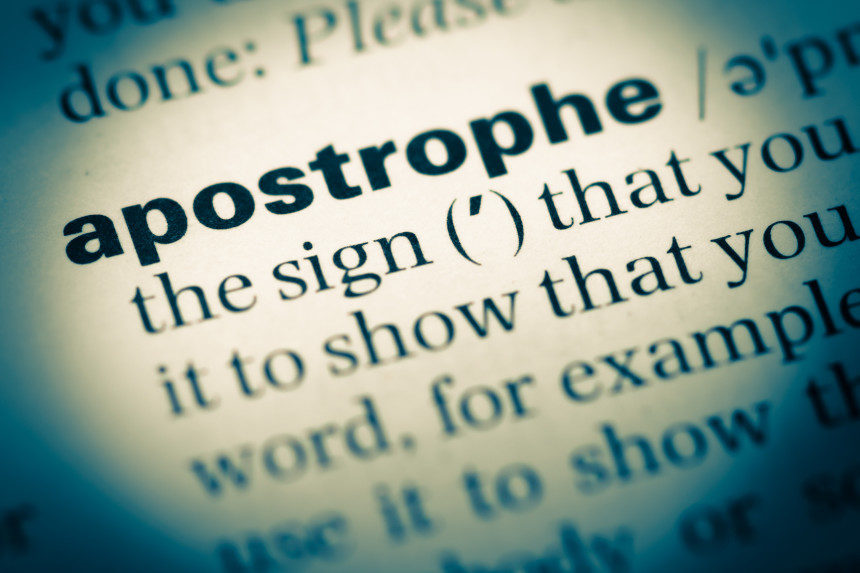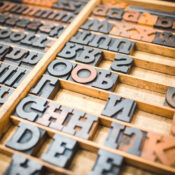Managing editor and logophile Andy Hollandbeck reveals the sometimes surprising roots of common English words and phrases. Remember: Etymology tells us where a word comes from, but not what it means today.
September 24 is National Punctuation Day, a time when people across the country, young and old, come together with one voice to talk about how they never really figured out how to use a semicolon.
I exaggerate, of course — but not a lot. Besides, I’m not writing about the semicolon today, but about a much more common punctuation mark that can be just as difficult sometimes: the apostrophe.
We learned in elementary school that the apostrophe is used primarily for two things: to indicate that a letter or letters were omitted (as in don’t and she’ll) and to show possession. As it turns out, these might not be two separate cases at all historically.
For decades, a popular theory on how apostrophe-S came to indicate the possessive in English was that it was a shortening of his used in a way we don’t anymore. Long ago, if you were, for example, taken by some swindler on the street, you might (as the theory goes) tell the story of being fooled by “that slubberdegullion his trick.” “Slubberdegullion his” was then contracted in print, probably to mimic how it would have sounded in speech, so that we have “that slubberdegullion’s trick.”
But that theory isn’t so popular anymore. More recent scholarship focuses on how certain nouns in Old English (genitive masculine and neuter nouns, to be technical) were made possessive by adding –es to them. Merriam-Webster uses the example of cyning, the Old English word for king, which in the possessive was cyninges. So the king’s speech in Old English would have been the cyninges spæc. According to this theory, the E was dropped (because it was not to be pronounced) and the apostrophe inserted to show its absence.
All this removing of letters points to how the punctuation mark got its name as well: The Greek apo “off, away from” was combined with strephein “to turn” to create apostrephein “avert, turn away” — apostrophos prosoidia was a mark showing where a letter had been “turned away” from its usual position. This was borrowed (and shortened) into Latin apostrophus, and eventually came to English (through Middle French) as apostrophe, a punctuation mark showing where a vowel had been omitted because it was not to be pronounced.
Though vowels are the more common letters dropped in contractions, these days any letter or letters might be replaced by that curly little gremlin. (Y’know what I’m sayin’?)
But even before apostrophe had made its mark as, well, a punctuation mark, it had found a life in literature — especially in theater. This type of apostrophe is more literal: It’s a literary device in which a character “turns away” from who they’re talking to in order to speak either to someone else (often someone who is not present) or to a personified inanimate object (O happy dagger!) or abstract concept (Be fickle, fortune!).
Which means that if you’re having a problem with a possessive and you try talking your punctuation into behaving, that’s technically an apostrophe to an apostrophe.
On usage: I mentioned in the beginning that apostrophes primarily served two purposes: to show an omission of letters and to indicate the possessive. You can read primarily as almost exclusively. The apostrophe is not used when you’re making a word plural except in two very specific cases:
- When you need to pluralize a lowercase letter referred to as a letter. A complex algebraic equation, for example, might contain three a’s and two i’s. The apostrophe keeps readers from confusing them with two-letter words. (Did you notice how the letters are italicized, too? That’s a convention from book publishing that you won’t find in newspaper writing, so the apostrophe is quite necessary for clarity there.)
- Many publications call for an apostrophe to pluralize do in the phrase do’s and don’ts — many, but not all; this is a matter of house style and not English grammar. That extra apostrophe aids in quick understanding and avoids the possibility of confusion with the Spanish word for two.
Happy punctuating!
Featured image: TungCheung / Shutterstock
Become a Saturday Evening Post member and enjoy unlimited access. Subscribe now




Comments
Great feature, Andy, If you read my comments, you’ll notice I always use the contracted version of any words I CAN contract. It’s just how I talk/speak normally. If I ever use bad grammar, it’s intentional to make a point more pointed if needed. “Ain’t” usually does the trick (combined with the right facial expression) for the unexpected shock value.
Wearing the mask now makes utilizing my face a lot more difficult to convey things without verbalizing. Being limited to my eyes and forehead IS limiting, but that mask ain’t goin’ anywhere.